The Pacific Ocean is massive and home to at least 34 native shark species. There are a lot of coastlines that many shark species prefer hunting close to. In the Pacific Ocean, there are approximately 25,000 islands. Within these waters are great, big, and beautiful coral reefs and volcanoes. For example, the Pacific Ocean is home to the Great Barrier Reef, where you can see reef sharks, lemon sharks, and leopard sharks.

Are you ready to learn about 12 interesting sharks that live in the Pacific Ocean? Keep reading!
1. Broadnose Sevengill Shark

Broadnose sevengill sharks live in the East Pacific.
©iStock.com/AlAlessandro De Maddalena
As you may have guessed, broadnose sevengill sharks have seven gills instead of the normal five. These large fish may look friendly and smiling, but they are great hunters with their tough skin. These large sharks grow up to 9.8 feet long and weigh 283 pounds. They also are not picky eaters and will consume stingrays, chimeras, juvenile sharks, and seals.
2. Spiny Dogfish

Spiny dogfish are tough sharks that use venomous spines to hunt for food and protect themselves.
©Joern_k/Shutterstock.com
Don’t let their small appearance fool you; spiny dogfish are tough sharks that use venomous spines located in front of each dorsal fin to hunt for food and protect themselves. While they have venomous spines, they are not dangerous to humans. Actually, these sharks grow 39 to 49 inches long. They migrate frequently and live in the Pacific Ocean, Atlantic Ocean, and Mediterranean Sea. During the cold winter months, they travel into deeper waters and return to coastal waters during the summer, feeding in dogfish packs.
3. Pacific Sleeper Shark
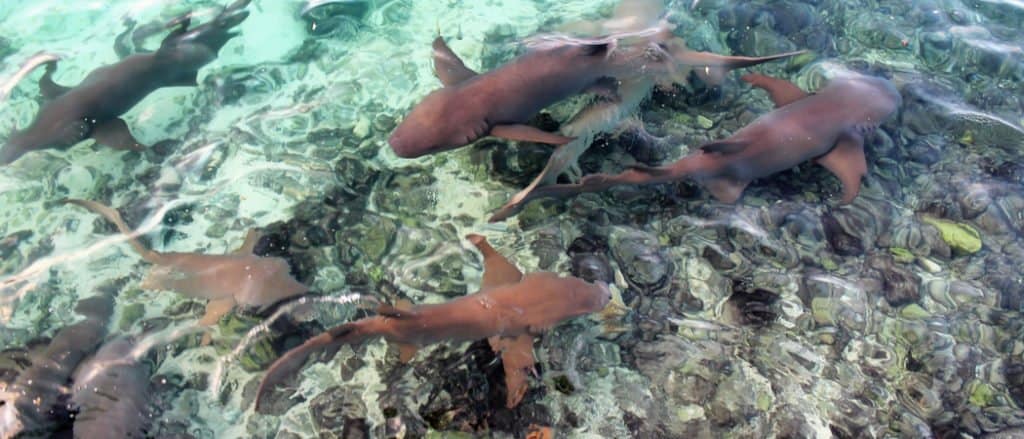
Pacific sleeper sharks live in deep parts of the Pacific Ocean.
©shweta.onlinetester/Shutterstock.com
Pacific sleeper sharks are quiet and rarely make appearances in front of humans. There is not a lot that scientists know about these fish, but they are common in the Pacific Ocean. They are extremely similar to the Greenland shark, except they do not reside in the Atlantic Ocean. The reason we likely know very little about these sleeper sharks is that they live in deep waters. They slowly swim and sneak up on their prey, sucking them into their open jaws. Few shark species live in the Arctic, and one is the Pacific sleeper shark.
4. Whale Shark

Whale sharks have unique white spots on their bodies.
©iStock.com/crisod
There is no way you can miss whale sharks. They are massive and slow-moving sharks that can be found 100 miles close to the coast of many islands in the Pacific Ocean. With their flat faces and white spots, they are easy to spot. Whale sharks are the gentle giants of the sea and hunt by keeping their mouths open while swimming. They only move 3 miles per hour but travel large distances worldwide, not just the Pacific Ocean. The largest whale shark ever recorded was 61 feet long. The average length of a whale shark is between 18 and 32.8 feet.
5. Nurse Shark
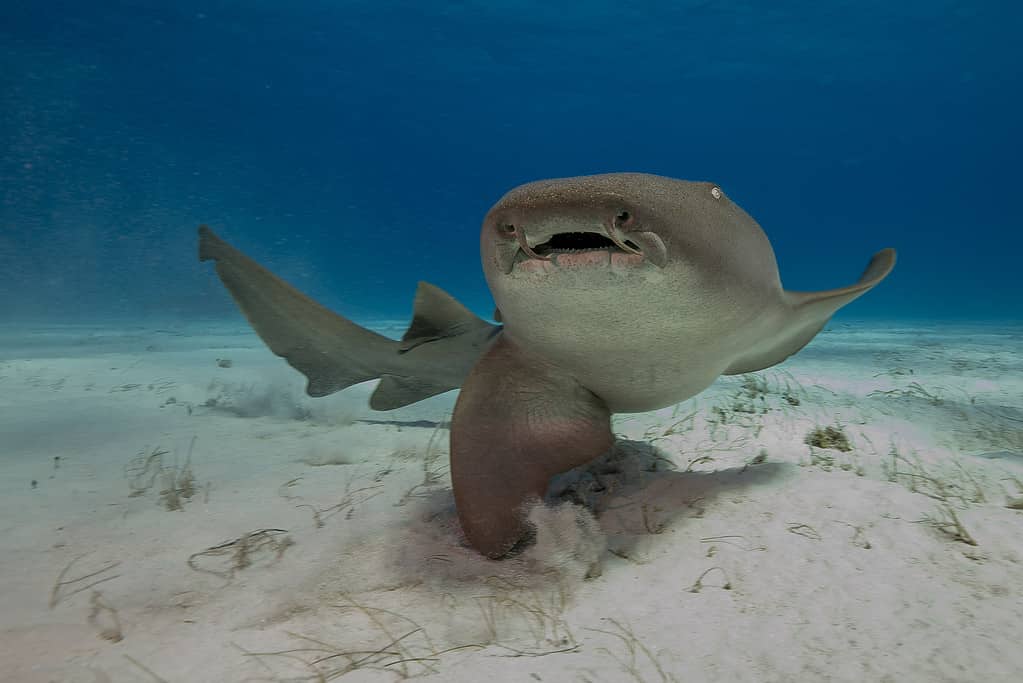
Nurse sharks can grow to a maximum length of 10 feet.
©Stevelaycock21 / CC BY-SA 4.0 – License
Another set of slow-moving and interesting sharks are nurse sharks. They are adorable sharks that spend most of their lives resting on the sandy floor. They are actually referred to as “couch potatoes” of the shark world and for a good reason. Nurse sharks only move when they are feeding at night, and still, they slowly feed by slurping up small fish and crustaceans in coral reefs. No two nurse sharks look alike either since this species come in brown, white, and gray. Interestingly, while nurse sharks do not hunt in groups, they do cuddle and rest together during the day in groups of up to 40 nurse sharks.
6. Mexican Hornshark

The average Mexican hornshark is only 28 inches long.
©Joe Belanger/Shutterstock.com
Mexican hornsharks have brown and black spots throughout their bodies and prefer swimming in coastal waters. Funny enough, Mexican hornsharks are not good swimmers, but they use their strong pectoral fins to crawl on the ocean floor. You can usually find them on California coastlines lying on sand or rocks. Most hornsharks eat at night and look for clams, oysters, and small fish.
7. Megamouth Shark
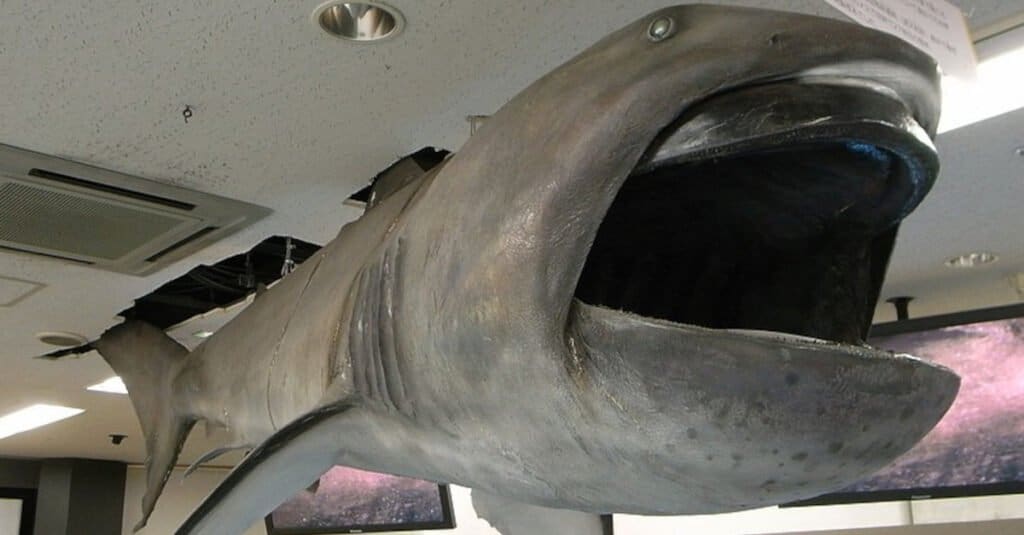
Megamouth sharks are deep sea sharks rarely seen by humans.
©opencage / CC BY-SA 2.5 – License
Another mystery shark on this list is the megamouth shark. It is a deep sea shark that was only discovered in 1976. Since then, it has only been caught a few times. Scientists still do not know much about this species, but a few sightings out of the approximate 100 were in the Pacific Ocean. Like the whale shark, the megamouth shark is a filter-feeder with an unusually large mouth. This shark species may even be larger than great white sharks. The largest megamouth shark ever caught was 25 feet long, but researchers believe megamouth sharks grow up to 16 feet long. The first place a megamouth shark was caught was in Hawaii.
8. Common Thresher Shark
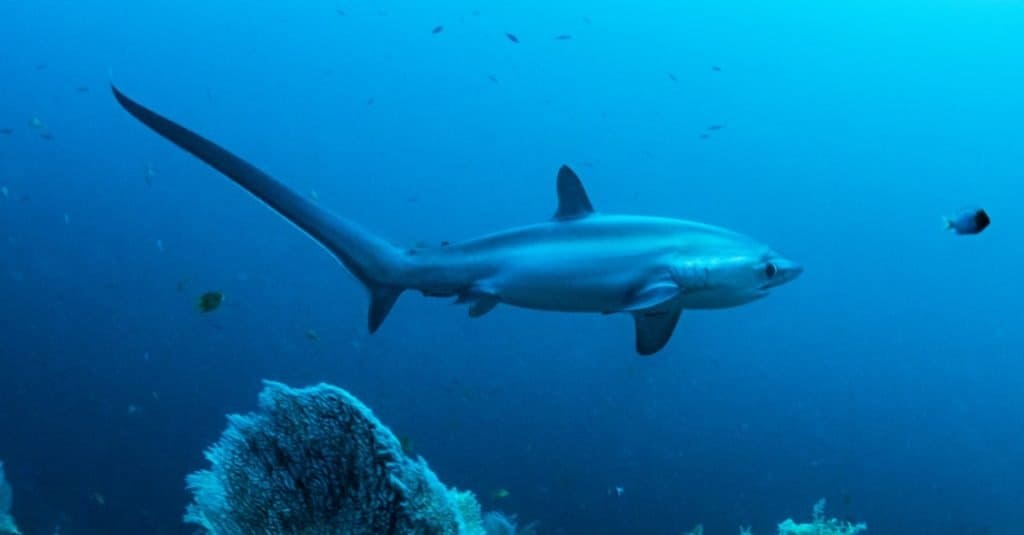
Common thresher sharks are aggressive predators.
©Shane Gross/Shutterstock.com
You wouldn’t want to be in the water with common thresher sharks. They are extremely aggressive predators and can get as long as 20 feet. This large shark species is known for its long tail. Common thresher sharks’ upper half is nearly half the size of their bodies. They use their tail to stun their predators before biting them. It is an effective hunting method. Common thresher sharks can be found in the eastern Pacific Ocean, while Atlantic thresher sharks live in the Atlantic Ocean.
9. Basking Shark

The basking shark is the second largest fish in the world.
©Martin Prochazkacz/Shutterstock.com
Basking sharks are unique because, like whale sharks, they are filter feeders. They feed by moving slowly in the water with their jaws wide open. Interestingly, their mouths open at least three feet wide. Adult basking sharks can be as long as 20 to 36 feet and weigh between 6,600 and 13,000 pounds. They mainly consume plankton and use their teeth to break down food. Unlike other sharks, basking sharks are social, but the social circles are split between females and males. They have been known to form schools of at least 100 basking sharks.
10. Shortfin Mako

The shortfin mako shark reaches 12 feet in length during adulthood.
©wildestanimal/Shutterstock.com
While shortfin mako sharks are not the largest sharks in the ocean, they are massive predators with aggressive traits. The coolest thing about this shark species, though, is their speed! The shortfin mako shark can travel and attack at speeds of up to 45 miles per hour. With its quick speeds and strength, it leaps out of the water, reaching highs. Adult mako sharks are in luck since they lack predators and are at the top of the ocean food chain. However, juvenile mako sharks under 8 feet long are targeted by other sharks.
11. Small-Spotted Catshark

Small-spotted catsharks are also known as sandy dogfish.
©iStock.com/atese
Small-spotted catsharks have tough skin and are small compared to other shark species. They’re one of about 115 dogfish. Each shark has unique spots all throughout its body but is mainly brown, white, and black. In shallow waters, small-spotted sharks hide in coral reefs and areas with lots of seaweed. Since they are small sharks, they have many predators like sevengill sharks. They are common in coastal waters near British Columbia and California.
12. Leopard Shark
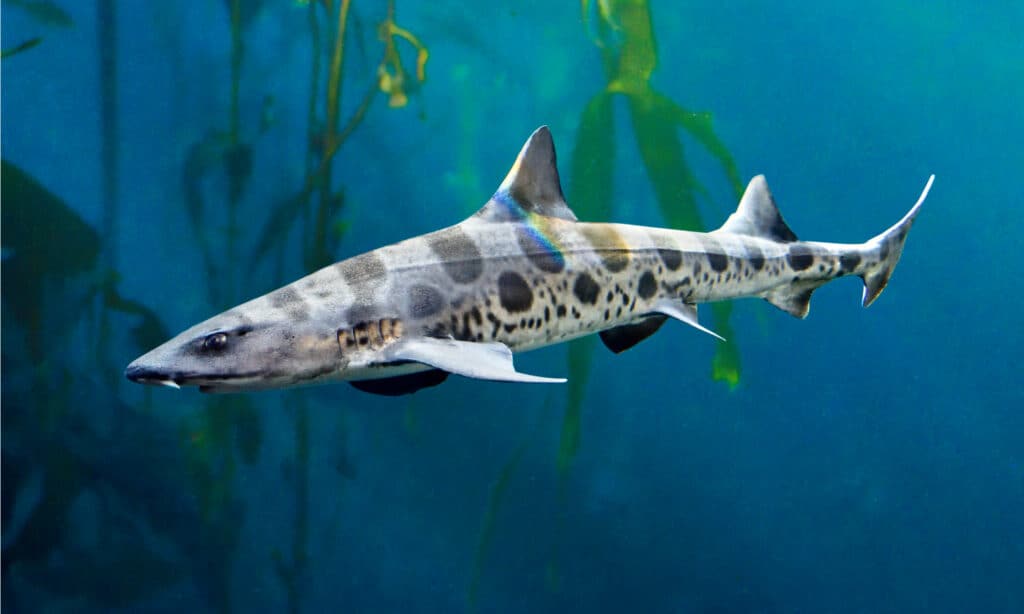
Leopard
sharks grow between 4 to 6 feet long.
©Barbara Ash/Shutterstock.com
Known for their leopard spots and marks, leopard sharks are native to the Pacific Ocean. They grow between 4 to 6 feet long by the time they hit adulthood. Leopard sharks are most commonly found off the coast of California. They are also completely made of cartilage, meaning they don’t have bones in their bodies, giving them flexibility as they swim. Preferring to live on the ocean floor, they rarely venture to the surface of the ocean and the coast during the morning.
Summary of 12 Sharks that Live in the Pacific Ocean
| Number | Shark |
|---|---|
| 1 | Broadnose Sevengill Shark |
| 2 | Spiny Dogfish |
| 3 | Pacific Sleeper Shark |
| 4 | Whale Shark |
| 5 | Nurse Shark |
| 6 | Mexican Hornshark |
| 7 | Megamouth Shark |
| 8 | Common Thresher Shark |
| 9 | Basking Shark |
| 10 | Shortfin Mako |
| 11 | Small-Spotted Catshark |
| 12 | Leopard Shark |
The photo featured at the top of this post is © Rich Carey/Shutterstock.com
Thank you for reading! Have some feedback for us? Contact the AZ Animals editorial team.






